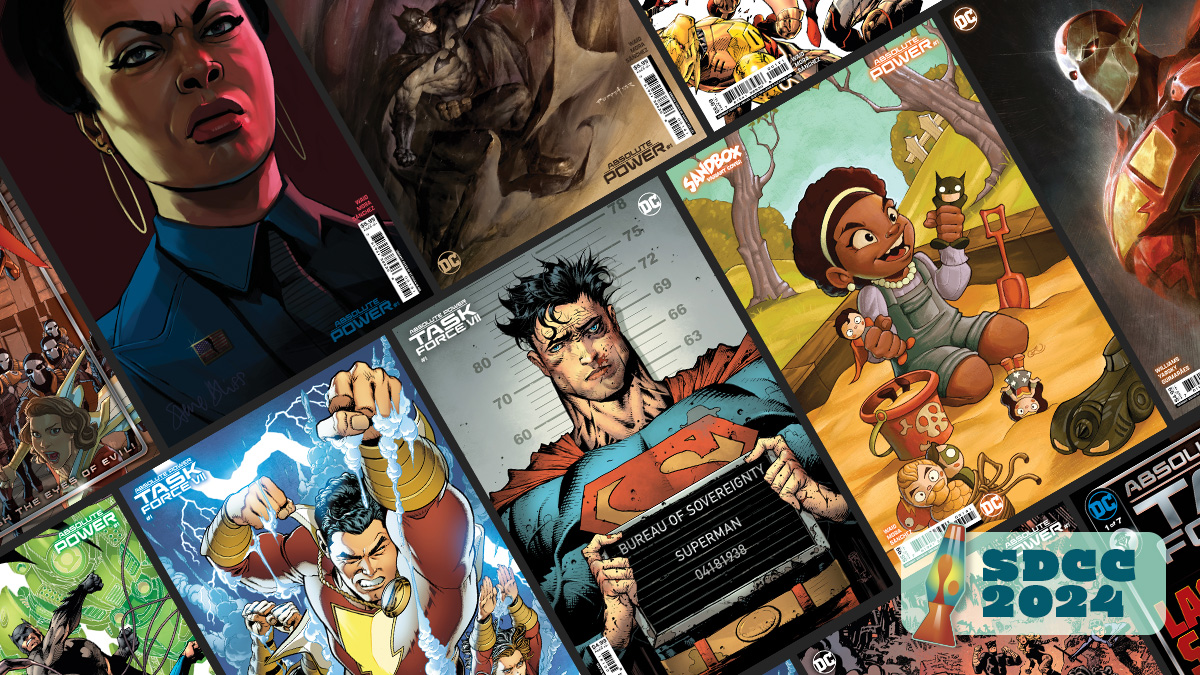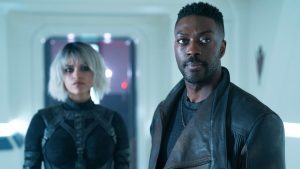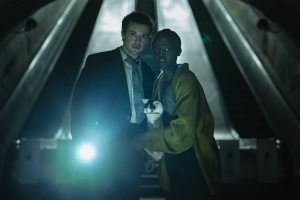
Absolute Power corrupts absolutely.
That statement almost always holds true in the real world but not often in the world of mainstream superheroes, especially those published by DC Comics. No matter how bleak things get, the denizens of the DC Universe can always look up in the sky to find Superman, their shining beacon of hope.
That is, until Absolute Power, the new DC crossover event from the all-star comics team of writer Mark Waid and artist Dan Mora, shoots Superman through the heart. To make matters worse, the Justice League has disbanded, leaving Earth without its greatest heroes.
“I really expected Absolute Power to be a Superman, Batman, Wonder Woman story,” Waid admits to Den of Geek. “And instead, it became very much a book about a bunch of different heroes, [including] Dreamer, Jon Kent, and Nightwing.”
Waid is an award-winning industry veteran who initially worked at DC Comics as an editor in the late ‘80s, overseeing legendary books such as Grant Morrison’s Doom Patrol and the first Elseworlds book Gotham by Gaslight. As a writer, Waid has written some of the most important comics of all time, including Kingdom Come with Alex Ross, “The Return of Barry Allen” arc in The Flash, and the “Tower of Babel” storyline in JLA.
In short, Waid knows the history of DC Comics better than almost anyone. And that makes him the perfect person to write the story of the DCU’s downfall.
The Absolute Power of the DC Team
“I was not crusading for it, but when the opportunity came up, I was very interested,” Waid says of penning Absolute Power, which he describes as “an event without a story.”
In Absolute Power, scheming U.S. government operative Amanda Waller expands beyond pressing supervillains into her service with the Suicide Squad and instead launches an attack on the nation’s heroes. With a combination of maneuvers that feel at once fantastic and pulled from the real world, Waller seeks to recreate the DCU in her own image.
The event didn’t come out of nowhere. Rather, it stems from Waller’s increased presence, both in the world of comics and in pop culture at large, thanks to Academy Award winner Viola Davis’s performance in The Suicide Squad and Peacemaker.
“They built her and built her and built her, especially over the last year or so, and wanted that big payoff, Amanda Waller versus the DC Universe,” Waid explains. On the page, that build-up occurred in several DC books of the past year, including Batman, Green Arrow, and Suicide Squad: Dream Team.
“Everybody brought something to the table. There’s a little bit of [Batman writer] Chip Zdarsky in this. There’s a little bit of [Green Arrow writer] Joshua Williamson in this. There’s a little bit of other writers in this. By the time it got to me, there were some ideas on the table that I was free to pick from or not pick from, and then bring something bigger to it myself that brought it all together and gave it a real sense of peril and immediacy.”
This approach helped Waid and Mora not only nail new characters such as Dreamer—Waid credits her co-creator Nicole Maines as “enormously helpful with getting a handle on that character”—but also situate the story in the larger DC Universe.
The limited run of issues prevented Waid from including everything he wanted in the event: “Look, if you gave me 12 issues to do Absolute Power, I could absolutely use them,” he exclaims. Fortunately, he did get access to every character he wanted.
A Different Kind of Crossover Event
Absolute Power isn’t Waid’s first company-wide crossover event, having written 1995’s Underworld Unleashed and the 2006 weekly series 52. But Absolute Power is something even more special for Waid.
“This is the first time anybody’s just said, ‘This is important enough to us where everyone’s on the table. Do what you need to do to tell a great story, and don’t worry about what’s going on in the other books. We’ll make it work on our end.’ And that’s basically what they did.
“Green Lantern was not originally envisioned as a tie-in book with this series. But Jeremy Adams was so on board with what we were doing that he voluntarily turned Green Lantern into an Absolute Power tie-in. There have been a couple of cases like that, where things that could have been off-limits were instead volunteered by the different writers.”
In a way, that collaborative approach hearkens back to 52, which Waid wrote with Grant Morrison, Greg Rucka, and Geoff Johns, with designs by the late, great artist Keith Giffen. But there are two big differences between 52 and Absolute Power.
“One of them is we didn’t have Superman, Batman, and Wonder Woman to play with, which is kind of the point of the series. The other big difference is [in 52] we were telling myriad stories that tied into each other. In Absolute Power, I’ve got 120 pages over four issues to really focus on one strong story with some side beats and personality beats and a little bit of subplot stuff here and there.”
As disappointing as that might be to readers who would love for Waid “to drift off and spend five pages with Adam Strange,” the focus also helped Waid distinguish Absolute Power from other comic book crossovers.
“We’ve all read crossovers where the main story is the main story, and then all the tie-in books are the C-list books, and it’s really just a cash grab to slap a logo on their cover. And I really resisted that,” Waid explains. “One of the first things I asked of the various DC writers is to devote three issues of Superman, Batman, and Wonder Woman to this story.”
He admits that the request “is a big ask, but at the same time, that makes it feel bigger, that gives it weight. Right off the bat, we have Superman, Batman, and Wonder Woman all going off on specific missions that feed into the climax that takes them off the board for issue three and gives the opportunity for a lot of other lesser characters to shine.”
If anyone is suited to writing B- and C-list characters, it’s Waid, with his encyclopedic knowledge of the universe. At the same time, Waid wanted to avoid the main pitfall of writing crossover events that reference decades of DC lore.
“The real challenge is making sure that my deep-cut knowledge of the DC universe isn’t so deep that it loses casual readers. I want to make sure that even some of the deep mining I’m doing with some key elements that go back 50 or 60 years into DC history are still clear and have context, and don’t require you to read the same comics I read when I was five.”
Supermorals
Unlike most bad guys in big crossovers, Amanda Waller has a clear moral compass, one she considers more complex and realistic than the good guys. That compass drives her to take out the heroes and establish her own set of crime fighters, including not only the Suicide Squad and the radical Batman robot Failsafe but also some surprising allies. The plot raises questions about how people with power do real good in the world.
“They have absolute power, and they answer to no one,” Waller says of the pantheon of DC heroes in Absolute Power #1. “They adhere to a child’s idea of morality, and like all children, they occasionally have tantrums.”
Morality has long been a thematic concern for Waid, as seen in Kingdom Come, as well as creator-owned projects such as Irredeemable and Empire.
“I think that morality is the DNA in all superheroes. They are built to demonstrate what the right thing to do is,” Waid explains. “But beyond that, I sometimes feel like there’s no other way for me to reach other people and communicate the importance of ethics and morality in the 21st century than through my stories. I don’t know a better way of doing it. I don’t know it really reaches anybody, but I can’t help but do that because I feel like that is an important message to put forth.”
That concern comes to the fore in Absolute Power, which involves contemporary issues, including deepfake videos and media misinformation campaigns.
“I spend a lot of time in the worlds of news, science, and politics, seeing what’s happening to our world,” Waid says. “But I never take a cynical approach, thinking that there’s no way to fight that in the real world. I still believe in Superman [and] Batman. I still believe in that element of fantasy. The trick really is to bring together elements of the real world and fantasy without compromising one or the other.”
For an industry veteran like Waid, maintaining that balance is just as important as coming up with new ways to surprise readers and himself. “On the off chance that some 10-year-old stumbles across the story I’ve written and is enlightened even for two minutes as to what the responsibilities of people with the power to change things are, that’s a win for me, and that’s an important mission for me.”
Absolute Power #1 is out now. Issue #2 hits stands on Aug. 7.
The post Mark Waid on How Absolute Power Changes Everything for the DC Universe appeared first on Den of Geek.






